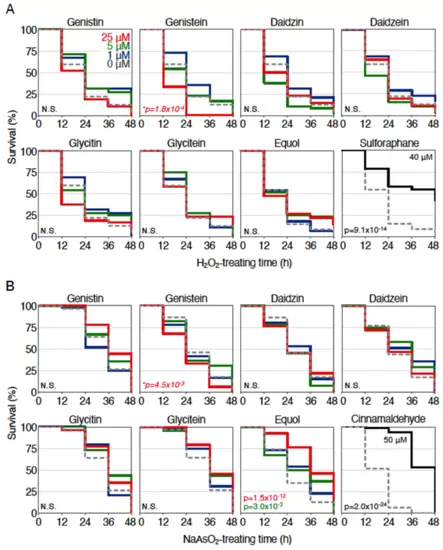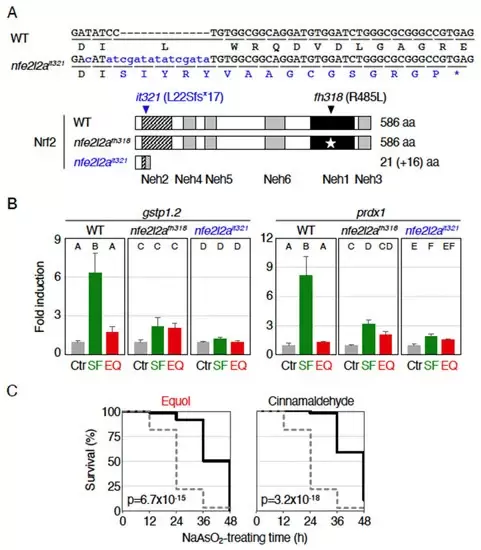FIGURE SUMMARY
- Title
-
Soy-Derived Equol Induces Antioxidant Activity in Zebrafish in an Nrf2-Independent Manner
- Authors
- Watanabe, A., Muraki, K., Tamaoki, J., Kobayashi, M.
- Source
- Full text @ Int. J. Mol. Sci.
|
Figure 1. Antioxidant effects of isoflavone compounds in zebrafish larvae. (A) Survival assays of hydrogen peroxide (H2O2)-treated zebrafish larvae using isoflavone compounds. Larvae (3.5 dpf) were pretreated with the indicated isoflavones at concentrations of 0 µM (gray, dotted), 1 µM (dark blue), 5 µM (green), and 25 µM (red). Sulforaphane (40 µM) was used as a control. After pretreatment for 12 h, the solution was changed to 2.8 mM hydrogen peroxide, and survival was measured every 12 h for 48 h. Each analysis was performed in triplicate, and the experiments were repeated multiple times. (B) Survival assays of sodium arsenite (NaAsO2)-treated zebrafish larvae using isoflavone compounds. They were calculated using the Kaplan–Meier method and analyzed with log-rank test; p values of <0.01 were considered to indicate statistical significance. Asterisks denote toxic effects of the indicated phytochemicals. N.S. indicates not significant.
PHENOTYPE:
|
|
Figure 2. Relationship between equol and the Keap1-Nrf2 pathway. (A) Antioxidant effects of equol in Nrf2-mutant larvae. Wild-type larvae (WT) or Nrf2-homozygous mutant larvae (nfe2l2afh318) at 3.5 dpf were pretreated with equol at concentrations of 0 µM (gray, dotted), 12.5 µM (orange), 25 µM (red), or 50 µM (pink). After pretreatment for 12 h, the solution was replaced with 1.9 mM (WT) or 1.4 mM (nfe2l2afh318) sodium arsenite (NaAsO2), and survival was measured every 12 h for 48 h. P values of <0.01 were considered to indicate statistical significance. (B) Expression of estrogen receptor-target genes in equol-treated larvae. Larvae at 3.5 dpf were treated with or without 25 µM equol (EQ) for 12 h, and the expression of vtg1, foxc1a, and esr1 was analyzed using qRT-PCR. The expression of untreated larvae (Ctr) was normalized to 1. Each experiment was conducted at least three times with duplicate samples. (C) Equol-induced expression of gstp1.2. Larvae at 3.5 dpf were treated with or without 25 µM equol for 12 h, and the expression of gstp1.2 was analyzed using qRT-PCR. (D) Venn diagrams showing upregulated (left) and downregulated genes (right) in 4-dpf larvae treated with 25 µM equol for 12 h identified using RNA-seq analysis. (E) List of Nrf2-target genes induced by the equol treatment in RNA-seq analysis. It should be noted that the induction of these genes was not canceled by the nfe2l2afh318 mutation.
EXPRESSION / LABELING:
|
|
Figure 3. Generation of Nrf2-knockout zebrafish. (A) Gene knockout of zebrafish Nrf2 using CRISPR–Cas9 technology. CRISPR target sites were designed in exon 2 of nfe2l2a loci (blue arrowhead). In nfe2l2ait321 line, 16-extra-amino-acids were added after the original Ile21 in nfe2l2a (diagonal stripes). (B) Expression of Nrf2-target genes in sulforaphane- or equol-treated larvae. Larvae at 3.5 dpf were treated without (Ctr) or with 40 µM sulforaphane (SF) or 25 µM equol (EQ) for 12 h in wild-type (WT), Nrf2-mutant (nfe2l2afh318), and Nrf2-knockout (nfe2l2ait321) larvae, and the expression of gstp1.2 and prdx1 was analyzed using qRT-PCR. Letters A-F indicate significant differences (p < 0.05). (C) Antioxidant effects of equol and cinnamaldehyde in Nrf2-knockout larvae. nfe2l2ait321 homozygous larvae at 3.5 dpf were pretreated without (gray, dotted) or with indicated phytochemicals (black, 25 µM equol or 50 µM cinnamaldehyde). After pretreatment for 12 h, the solution was replaced with 1.4 mM sodium arsenite (NaAsO2), and survival was measured every 12 h for 48 h. p values of <0.01 were considered to indicate statistical significance.
|
Acknowledgments
This image is the copyrighted work of the attributed author or publisher, and
ZFIN has permission only to display this image to its users.
Additional permissions should be obtained from the applicable author or publisher of the image.
Full text @ Int. J. Mol. Sci.



